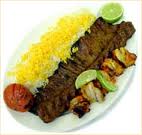
The Iranian culinary style is unique to Iran, though has historically both influenced and has been influenced by Iran’s neighboring regions at various stages throughout its history. Specifically, these have been mutual culinary influences to and from Mesopotamian cuisine, Anatolian cuisine, Caucasian cuisine, Indian cuisine, and Central Asian cuisine. Many foods famously associated with Middle Eastern, and indeed World cuisine have their origins in Iran, such as kebab and ice cream, and cookies. Fresh green herbs are frequently used along with fruits such as plums, pomegranates, quince, prunes, apricots, and raisins. Typical Persian main dishes are combination of rice with meat, lamb, chicken, or fish and some onion, vegetables, nuts, and herbs. To achieve a balanced taste, characteristic Persian flavorings such as saffron, dried limes, cinnamon, and parsley are mixed delicately and used in some special dishes.
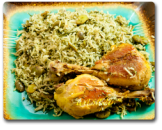
BAGHALI POLO WITH CHICKEN
The food is what Naji had for lunch that day. To find out how Naji liked the food read "Naji and the mystery of the dig"
1- Mince the dill. 2- Wash the rice. 3- Boil 5 cups water. DIRECTIONS: 1- Put the chicken thighs in a pot. 2- Add Turmeric and salt as needed to the pot. 3- Top the pot off with boiling water and simmer for 30 minutes. 4- Pour the Fava beans in a small pot, add boiling water and simmer until the beans are tender. Drain the water and let it cool of for few minutes, peel the skin off of the beans (try not to smash the fava beans). 5- Pour the rice in a large pot. Empty the water of the chicken's pot into this pot. 6- Add the dill and salt to the pot, stir the mixture and let simmer until the water is steamed off. 7- In a large pot, apply oil, lay the chicken thighs across the pot. 8- Pour the rice on top of the chicken thighs than add the Fava beans on top. 9- Cover the pot with a large napkin and put the lid on. 10- Cook for 20 minutes with low heat. The image and the recipe above is from a great website & blog about Persian cuisines "aashpazi" (www.aashpazi.com). Vist the site for more detail about Baghali Polo calories and nutritional facts. |
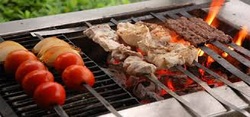
Iranian cuisine includes a wide variety of foods ranging from chelow kabab (rice served with roasted meat: barg, koobideh, joojeh, shishleek, soltani, chenjeh), khoresht (stew that is served with white Iranian rice: ghormeh sabzi, gheimeh, fesenjān, and others), āsh (a thick soup: for example āsh-e anār), kuku (vegetable souffle), polo (white rice alone or with addition of meat and/or vegetables and herbs, including loobia polo, albaloo polo, sabzi polo, zereshk polo, baghali polo and others), and a diverse variety of salads, pastries, and drinks specific to different parts of Iran. The list of Persian recipes, appetizers and dessts is extensive.
*** Do you want to play a cooking game? Scroll down to the bottom of this page. 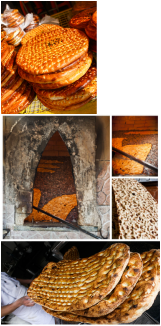
Persian Breads
These photos are among many pictures from a great blog post about Persian bread by "I live in a frying pan " blog. Read the blog if you want to experience the wanders of Persian breads. Below is the url and link to the blog. http://www.iliveinafryingpan.com/breads-iran/ 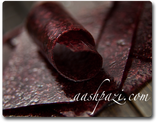
Lavashak Aloo (Prunes Fruit Roll)
Iranian kids love fruit rolls. Here how to make them:
PREPARATIONS: 1- Wash the prunes thoroughly. DIRECTIONS: 1- Transfer prunes to a pot. 2- Add just enough water to cover the prunes in half. 3- Cover the pot with a lid and simmer for 30 minutes over medium heat. 4- While boiling, stir the prunes. At this point, the prunes should fall apart and the seeds should fall right out. 5- Continue boiling the prunes for 30 more minutes. 6- Turn off the heat, Mash the prunes down and allow them to cool down. 7- Run the prunes through a colander to get the seeds and undissolved skin. 8- Cover a cookie pan with plastic wrap. 9- Spread the prunes across the pan to make a thin layer. 10- Keep the Lavashak outdoor for few days (depending on the heat) until it dries partially or reaches the density you would prefer. Click here for a video on how to make fruit roll and the above recipe's Calories and nutritional facts. The image and the recipe above is from a great website & blog about Persian cuisines "aashpazi" (www.aashpazi.com). |

